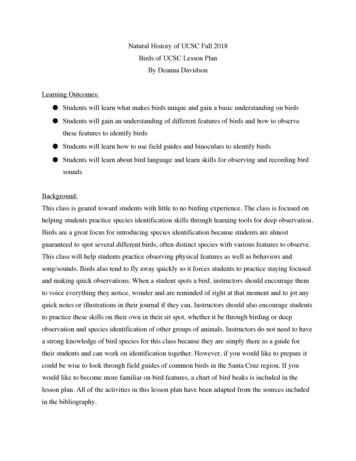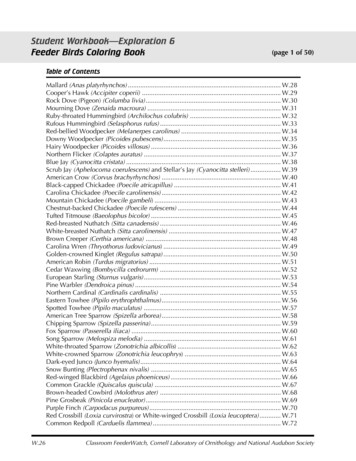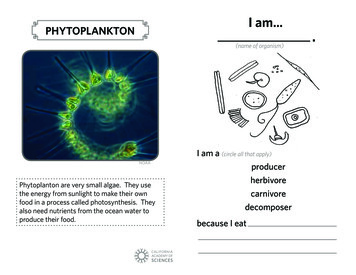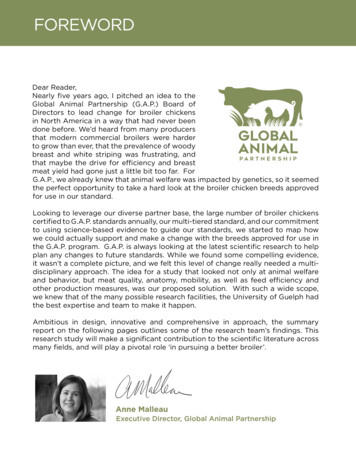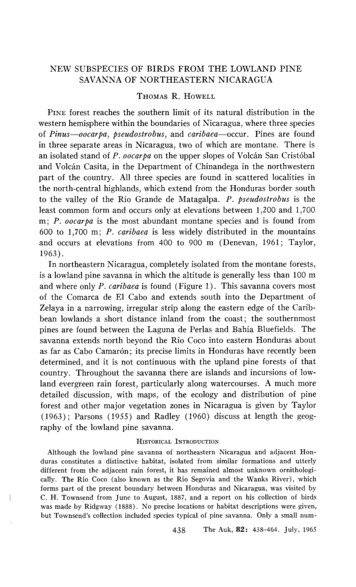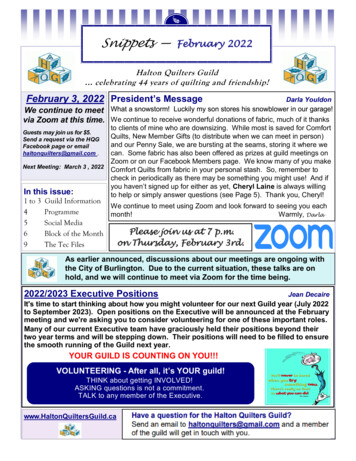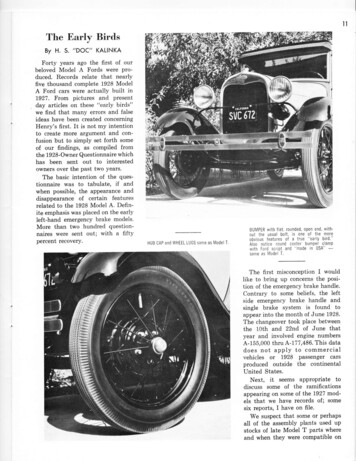
Transcription
llThe Early BirdsBy H. S. 'DOC" KALINKAForty years ago the first of ourbeloved Model A Fords were produced. Records relate that nearlyfive thousand complete 1928 ModelA Ford cars were actually built in7927. From pictures and presentday articles on these "early birds"we find that many errors and falseideas have been created concerningHenry's first. It is not my intentionto create more argument and confusion but to simply set forth someof our findings, as compiled fromthe 1928-Owner Questionnaire whichhas been sent out to interestedowners over the past two years.The basic intention of the ques-tionnaire wasto tabulate, ifandwhen possible, the appearance anddisappearance of certain featuresrelated to the 1928 Model A. Definite emphasis was placed on the earlyleft-hand emergency brake models.More than two hundred questionnaires were sent out; with a fiftYpercent recovery.BUMPERHUB CAP and \{HEEL LUGS same as Model Twith flat. rounded, open end, with'out the usual bolt, is one of the moreobvious features of a true "early bird."Also notice round center bumperclampwith Ford scriPt and "made in USA"same as ltiodelT.-The first misconcePtion I wouldlike to bring up concerns the Position of the emergency brake handle.Contrary to some beliefs, the leftside emergency brake handle andsingle brake system is found toappear into the month of June 1928.The changeover took place betweenthe 10th and 22nd of June thatyear and involved engine numbersA-155,000 thru A-177,486. This datadoes not apply to commercialvehicles or 7928 passenger carsproduced outside the continentalUnited States.Next, it seems apProPriate todiscuss some of the ramificationsappearing on some of the 1927 models that we have records of; somesix reports, I have on file.We suspect that some or PerhaPsall of the assembly plants used uPstocks of late Model T Parts whereand when they were comPatible on
t2The Early Birds, continueclEMERGENCY BRAKE HANDLEgooseneck, located atREAR BUMPER CLAMPS have Ford script.with pistol gripfar left, next todooron driver side,the first very early Model A's. Despite Ford directives, many of theearly Model A's sported Model Tcenter bumper clamps, with "madein USA" in block letters beneaththe Ford script.I hesitate to comment on thefollowing, but at least two thousandpairs of open-end front bumperswere released, the vast majoritygoing to foreign assembly plants,especially to Canada.Many of the sheet metal bodycomponents on the early A's wereactually bolted and screwed together instead of being spot weldedor riveted. Many of the floor panelpatterns and rear fender well patterns difiered not only from car tocar but also from one side of the carto the other.fn retrospect, from forty yearsaway, one might summarize thatthe assembly plant did not receivea full stock of parts to build acomplete car at first. Thus necessitating the use of whatever they hadon hand or could acquire in orderto make it saleable and roadworthy.It cannot be denied that the firstdays were not difficult and trying,since from mid October to December37, 1927, only five thousand vehicleswere manufactured. Compare thisto the near record production rate?"'EARLY RADIATOR CAP at left has deeperrecess around top than later model at right.RUNNINGB0ARD APR0Nissmooth andstraight along the top. Later carhave slight raise (or "bump")wouldto cleartheemergency brakerod underneath at pointjust forward of rear fender, aboutstreak of sun reflection begins.where
l3of nine thousand units per daY in7929.After only a little research on thesubject, one begins to imagine thatthe Model A must have been designed while it was being assembled.The number of changes evident onthe first early five thousand or eventwenty thousand Model A Fordsmanufactured defies imagination ordescription. I will describe, however,just a few of the most obviousdeviations from what maY be considered a "typical" 1928-1929 Ford.The radiator shell lacing, orwebbing, was not riveted onto theshell but was interwoven on theshell (like Model T radiator shells).Clutch and brake Pedals werecompletely smooth, with no ribbedpattern or raised boss on the endsto prevent your foot from sliPPingoff. Upon casual insPection, onemight think that these Pedals wereIike an "A" withworn smooththe odometer -around a couPle ofof early Model A canbe seen in this view: the fan shroud, thewoven through the radiatorhood lacins-"powerhouse" generator withshell. theSEVERAL FEATURESSHORTER CHOKE ROD.OFFSET STARTER ROD.side-mounted cutout and the metal conduit.times. Actually, these smooth clutchand brake pedals aPPeared on atleast the first 70,000 or 80,000Model A Fords.The "powerhouse" generator,which is considered bY some as atrademark of the 1928's, actuallYappeared in three different forms.The very early A's had a cadmiumplated adjusting arm which held thegenerator in Position. The cutoutwas located on the side of thispowerhouse generator. The mostsignificant difierence, howevet, wasthe finish of the back or end coveron the generator. The end coverwas either unpainted aluminum ormetal plated with dull nickel orcadmium, again unPainted.Another earlY item was the ignition cable with the long, five-inchsolid end; the end which screwedinto the distributor. This solid portion was integral with and included
the forged conduit cliP ('2" inchthick), through which it is boltedtight to a head bolt. A rectangularBriggs and Stratton patent plate isriveted to the solid end.Other "early bird" features arethe fan shroud, the ofiset starterrod, metal conduit, short choke rod,a smooth runningboard aPron justforward of the rear fender (insteadof the bump which clears the emergency brake rod), and a very subtledifierence in the contour of the frontfenders where they sweeP down tothe frame, etc.These difterences will be foundwhen comparing the earlY 1928 witha later 1928, or at929. But as men'tioned before, even the earlY oneswill vary from car to car. Do notexpect two cars of similar dates tolook alike. We previously discussedthe Problem ofone cause for thisfactory changeover and parts short'but another factor wouldages-NUMBER A-1149on engine block ofBaudino Tudor dates it within thedays of December 1927.course be the matter oi Partsreplacement. When a car was returned to the Ford agency forservice, or especially for repair, itwould be modified with the latestpart then being issued by the factoryservice department. Naturally, afterthirty or forty years of wear andaccumulated grime, that rePlacement part is going to look just aslegitimate and original as all theother parts on the car.One of the earliest cars in ourquestionnaire file is a Tudor belonging to Andy Baudino of Tustin,California. The engine number isA-1149. It has almost all of the"early bird" features described hereand was used as the model to illustrate this article. Incidentally, it isbeautifully restored; a first Placetrophy winner at the AlbuquerqueNational Meet and a recent "AwardWinner" in The Restorer. lVol.11-6, page 5.1The earliest earlY bird in ourfile is another beautifuly restoredtrophy winner, and also from California; a Phaeton belonging to JoeCrum of Oceanside.ofThe Early Birils, continuedthefirst fewThe EarliestBy JOE CRUMOur early-bird Phaeton was soldnew in the Oklahoma CitY area inDecember 1927. The buYer was aMr. Martin. We bought the car,still in Oklahoma, in 1959' Betweenthat time it had a very interestingbut very rugged life'The correspondence I receivedwhile tracing the car's historY tofind its origin was perhaps as interesting as the car itself.After finally locating Mr. Martinhe explained how the original engine was changed in order to get the"new" type connecting rods, andeliminate the X-beam rods. Whichanswered the question of whY theengine number, A-102758, was somuch bigger than the frame number, 746. The first engine numberwas 797, we learned'No number was ever found on thefirewall or anywhere else, even aftera chemical wash. We almost missedseeing the frame number, it was sofaint.After Mr. Martin sold the car itwas used on a farm near McAlister,Oklahoma, until it was Purchasedby my brother, HarrY Crum, in1958. At that time it was stillstill in running condition, as it had alwaYs been, andwas being used as a PickuP to haullicensed andloads around the farm. Consideringthe kind of use it served, I cannotunderstand why the bodY was nevercut, as so many of them were undersuch circumstances. But instead,the wood etc. was just loadedonthe rear seat and floor boards. Eventhe top bows were left on, foldeddown out of the waY and securedwith, you guessed it, baling wire.The car was so rough, in such badshape, that I would not have considered it had it not been one ofthe first ones, and so comPlete.Everything was there, such as itwas.After I bought it, a friend of mineOklahoma loaded it on a cartrailer (although it was still inin
l512EarliestEarly BirdsAS RECORDED BY THEtKALINKA QUESTIONNAIREA.797!:'.,.iPHAETONJoe Crum-0ceanside, CaliforniaA.1I49TUDORAndy Baudino-Tustin, CaliforniaA.1639 PHAETONKen Webber-Manhattan, KansasA-3064 CoUPEBill Strum-Neenah, WisconsinA-3182 TUDORJim Lewis-Modesto, CaliforniaA.4568ROADSTERJohn Buesing-St. Paul, MinnesotaA.5877Johnrunning condition)Sapulpa, Oklahoma,to bring it to very helpful. We also foundwhere I was to Restorer to be a great helP.pick it up. On the way, the trailerbroke loose and turned over, righton busy Highway 51 ByPass inTulsa. That's like turning over inthe middle of the Hollywood Freeway in Los Angeles at five o'clockin the evening-if you can imagine.It made for a lot of confusion, andof course a lot more bumps on thepoor old Phaeton.The restoration was a familYproject with my wife, Gretchen, andsons, Gary and Daryl, doing theirshare. Together we put in, by accurate count, exactly 4,016 man-hourson the restoration. Which just goesto prove that amateurs are not nearly as fast as professionals - andperhaps not as good, either. Butcheaper.We did it all ourselves, includingthe upholstery and even the nickelplating. Fortunately, I have accessto the equipment. We were also fortunate to have a complete collectionof Service Bulletins, plus a collection of the letters sent out bY theFord Motor Company to dealersfrom September 1927 to the end ofModel A production. These were?heIttook a lot of searching to getpieces, eventually gettingrightthefrom fourteen difneededwhat weplusCanada. Thereferent States,are no oddball replacement parts onIttheis completely ARgear,everyetc.fenders, running- It wasthing genuine and original.a lot of work, time and trouble, butwe are now very pleased with it.It has apparently pleased a fewjudges, too, since we have won threenational trophies with the car. Ithas not been out in comPetitionsince the San Diego National Meetin 1963, but we Plan to take it tothe National Meet in 1968.During the time we were restoringthe Phaeton there was no organizedresearch about early Model A's andvery little information was available.Now, thanks to the Kalinka questionnaire, and the publicity givento it by The Restorer, owners ofearly A's have a point of reference,a way to compare notes. He, andthe club, and the participating carowners, are to be commended fortaking some of the guesswork out ofearly-A restoration.the car.A-596IROADSTERXifos-Granite Springs, New YorkTUDORLoganWhitehurst-Gilroy, California'A-7529 TUDORPhilip Adkins-Monterey, CaliforniaA.I0677 TUDORJohn Tremble-San Luis 0bispo, Calif,A.13727H. S.PHAETONKalinka-Chilton, WisconsinA-I8992TUDORRalph Busby-Merced, CaliforniaPOSTSCRIPTS:FORTY YEARS ACOFor more about the early daysof lrlodel A, how it w"as designcd, thepeople involved, etc., sec the s-partseries Devclopntent ol the Mod.el Aby Art Nliller published in 1963,beginning in our lUay-June issue ofthat year. (Vol. 8-1, page 4.)THE EARLY BIRDSThe Kalinka research is still ilprogress. If there is an early birdroosting in your garage and you wouldlike to help in this interesting andworthwhile proiect, send for a copy ofthe 3%-page questionnaire. Send astamped, self-addressed envelope toH. S. Kalinka DVN{, Route l,Chilton, lVisconsin 53014.THIj EARLIESTGot an early Ntodel A? One earlierthan Joe Crum's Phaeton? If so, wewould like to hear about it and so wouldoul readers. Please send informationand pictures to thc editors, Box 2564,?omona. California 9I766.
ll The Early Birds By H. S. 'DOC" KALINKA Forty years ago the first of our beloved Model A Fords were pro- duced. Records relate that nearly five thousand complete 1928 Model A Ford cars were actually built in 7927. From pictures and present day articles on these "early birds" we find that many errors and false ideas have been created concerning


